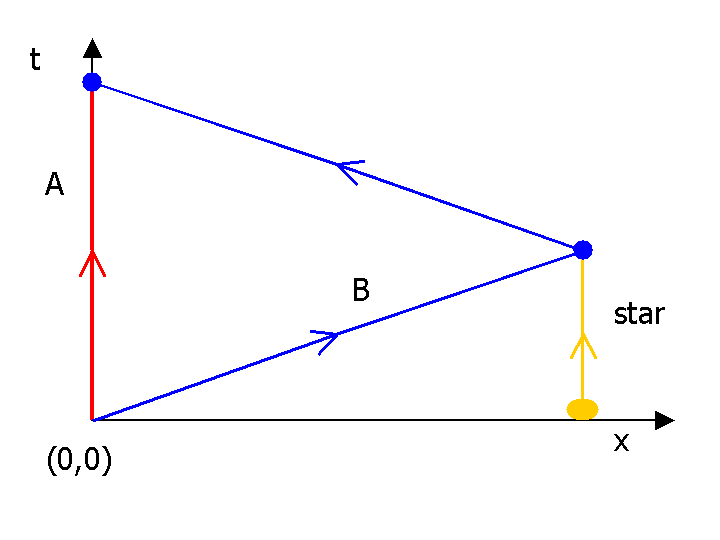Yes, yes, I know, this has been covered a gazillion times by every amateur, would-be physicist on the internet. I just haven't found a website that I thought explained it both clearly and properly.
For those who need a reminder: the twins paradox is a scenario in special relativity. To understand the paradox you only need to know one thing: moving clocks run slower than stationary clocks.
You have two twins: A and B. A remains on Earth. B boards a spaceship and whizzes off to a distant star and then returns. A sees the clock on B's spaceship running slow, so B will be younger than A when B returns. However, everything is relative. From B's point of view it is A that has been moving and so it is A's clock that runs slower. So A should be younger on B's return - an apparent contradiction.

Some texts are content to point out that there is a clear asymmetry in the twins behaviour. B gets accelerated and decelerated several times, whereas A does not and therefore the "paradox" is a non-starter. Others describe solutions to the paradox that ignore the accelerations and decelerations, which is a shame, because a lot of the interesting physics takes place during the accelerations and decelerations.
I'm going to explore an approximate approach, where the changes in velocity happen very quickly, but not instantaneously.
The diagram above is a space-time diagram. It shows the position in space and time for twin A and twin B. Twin B moves off to the right towards the star and also travels upwards through time. Twin A stays still, but also moves upwards through time. Twin B reaches the star and then returns home to meet A back on earth again.
next
For those who need a reminder: the twins paradox is a scenario in special relativity. To understand the paradox you only need to know one thing: moving clocks run slower than stationary clocks.
You have two twins: A and B. A remains on Earth. B boards a spaceship and whizzes off to a distant star and then returns. A sees the clock on B's spaceship running slow, so B will be younger than A when B returns. However, everything is relative. From B's point of view it is A that has been moving and so it is A's clock that runs slower. So A should be younger on B's return - an apparent contradiction.
Some texts are content to point out that there is a clear asymmetry in the twins behaviour. B gets accelerated and decelerated several times, whereas A does not and therefore the "paradox" is a non-starter. Others describe solutions to the paradox that ignore the accelerations and decelerations, which is a shame, because a lot of the interesting physics takes place during the accelerations and decelerations.
I'm going to explore an approximate approach, where the changes in velocity happen very quickly, but not instantaneously.
The diagram above is a space-time diagram. It shows the position in space and time for twin A and twin B. Twin B moves off to the right towards the star and also travels upwards through time. Twin A stays still, but also moves upwards through time. Twin B reaches the star and then returns home to meet A back on earth again.
next






